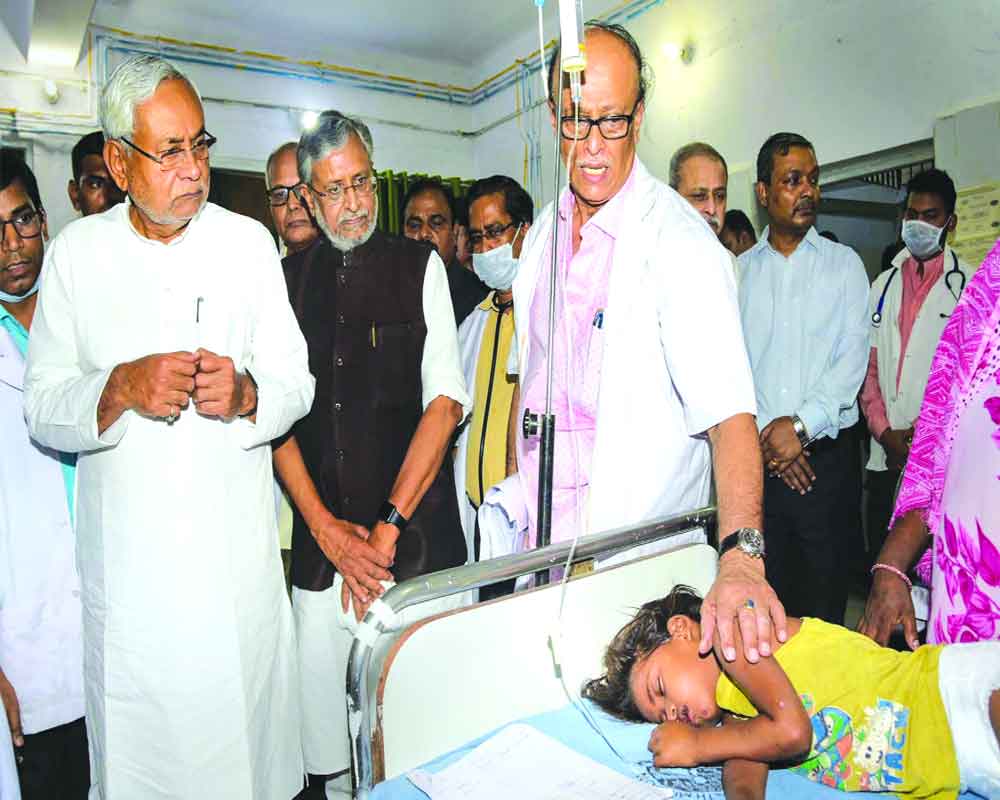Deaths due to Acute Encephalitis Syndrome (AES) or “chamki fever” in Bihar’s Muzaffarpur had crossed the three-digit mark before 2019 also. Not once but in as many as four calendar years.
An analysis by experts has found that the death toll has been high whenever temperature and humidity were recorded to be more than 38 degrees Celsius and 50 per cent respectively for consecutive days. This happened in 2011 (197 deaths), 2012 (275) 2013 (143), 2014 (375) and 2019 (106). The epidemic had been at its worst in 2014, when 375 deaths were reported.
Bihar Health Secretary Sanjay Kumar said so far 106 children have died this year and more than 430 others between the ages of 4 and 10 years are being treated at Sri Krishna Medical College and Hospital (SKMCH) and Kejriwal hospital in Muzaffarpur.
AES is fatal viral infection hitting the brain and leading to coma. At times survivors are left with serious disabilities — mental and physical.
While 2019 has not been an isolated year when the AES deaths have been reported, it is only now that the Bihar Government has woken up to announce a string of measures to contain the deadly disease. In fact, the Nitish Kumar-led Bihar Government also did not learn lessons from nearby Gorakhpur in Uttar Pradesh which had reported outbreak of the disease in 2017.
On Tuesday, Nitish, whose visit to the hospital met with a protest from the angry relatives over the Government’s callousness in ensuring timely preventive steps, announced to increase bed strength in hospitals in the district and ordered an environmental study on AES.
At the Central level, Union Health Minister Harsh Vardhan too held a meeting of a multi-disciplinary group of experts in the national Capital and deliberated on the factors causing high child mortality in the AES/JE cases in the district.
Harsh Vardhan also stressed the need for research on AES to identify the disease that is still not identified and for that research facility should be developed in Muzaffarpur.
The socio-economic profile of the households which have reported the cases, their nutrition profiles, issues such as the ongoing heatwave, reported high percentage of hypoglycemia in the children who have died, the prevailing health infrastructure in the district and other factors that could have aggravated the cases were deliberated threadbare.
According to the health experts, most of the children dying from AES belong to the poorest of the poor — the Mahadalit community, including Musahar and Scheduled Castes — and most of them were malnourished.
Senior paediatrician Dr Arun Shah was of the opinion that only awareness programme would not help in preventing the deaths. The kids are afflicted with another disease or are malnourished.
“I have been observing the cases of AES for last two and half decades. I have minutely studied the cases of the deaths. I have found that these children, either fallen prey to the disease or have been undergoing treatment, are affected with lack of sugar in their body. This is called hypoglycaemia in medical term.
The affected children are either suffering from another disease or are malnourished. These kids are from below poverty line and have been fed very poorly. So, they don’t have stock of glucose in their body to release in emergency condition,” Dr Shah has been quoted saying in a report.
Dr Gopal Shankar, the acting HOD of SKMCH has pointed out that deaths occurred due to “environmental factors” such as the heatwave and poor rainfall in the area. He said that in other parts of northern India there is fluctuation in temperature and humidity, and the nights are cooler, but in Muzaffarpur humidity increases at night making it worse than the day, especially for children.
He added that rainfall is the only remedy to this outbreak. “When it rained a few days ago, the following day witnessed a drop in the number of AES patients in the hospital. Now when it hasn’t rained, the numbers are increasing,” he said.
Refuting the litchi theory, Dr Shankar asked if people had stopped eating litchis during the years when there were no cases of AES in Muzaffarpur. “Sick children also do not have symptoms of abdominal pain to prove the litchi theory,” he pointed out.
In 2017, Yogi Adityanath-led Uttar Pradesh Government launched Action Plan 2018 in collaboration of the World Health Organisation (WHO) and Unicef for containing AES. A massive vaccination drive and a sanitation campaign were launched. By virtue of this rampant drive, cases of AES dropped by about two-thirds in 2018 -- as compared to 2017.


























